2006 GMC SIERRA 1500 light
[x] Cancel search: lightPage 93 of 600
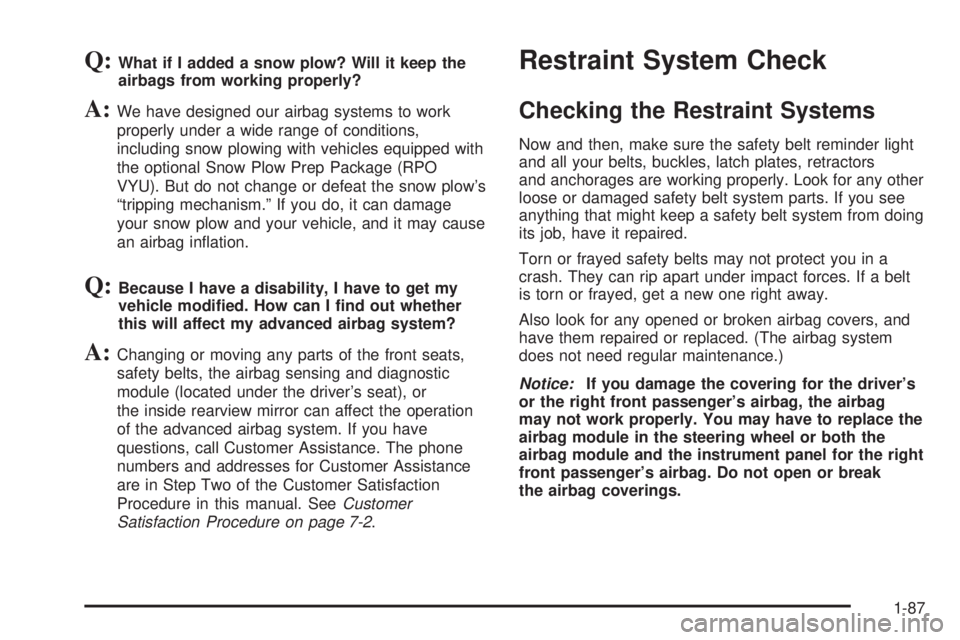
Q:What if I added a snow plow? Will it keep the
airbags from working properly?
A:We have designed our airbag systems to work
properly under a wide range of conditions,
including snow plowing with vehicles equipped with
the optional Snow Plow Prep Package (RPO
VYU). But do not change or defeat the snow plow’s
“tripping mechanism.” If you do, it can damage
your snow plow and your vehicle, and it may cause
an airbag in�ation.
Q:Because I have a disability, I have to get my
vehicle modi�ed. How can I �nd out whether
this will affect my advanced airbag system?
A:Changing or moving any parts of the front seats,
safety belts, the airbag sensing and diagnostic
module (located under the driver’s seat), or
the inside rearview mirror can affect the operation
of the advanced airbag system. If you have
questions, call Customer Assistance. The phone
numbers and addresses for Customer Assistance
are in Step Two of the Customer Satisfaction
Procedure in this manual. SeeCustomer
Satisfaction Procedure on page 7-2.
Restraint System Check
Checking the Restraint Systems
Now and then, make sure the safety belt reminder light
and all your belts, buckles, latch plates, retractors
and anchorages are working properly. Look for any other
loose or damaged safety belt system parts. If you see
anything that might keep a safety belt system from doing
its job, have it repaired.
Torn or frayed safety belts may not protect you in a
crash. They can rip apart under impact forces. If a belt
is torn or frayed, get a new one right away.
Also look for any opened or broken airbag covers, and
have them repaired or replaced. (The airbag system
does not need regular maintenance.)
Notice:If you damage the covering for the driver’s
or the right front passenger’s airbag, the airbag
may not work properly. You may have to replace the
airbag module in the steering wheel or both the
airbag module and the instrument panel for the right
front passenger’s airbag. Do not open or break
the airbag coverings.
1-87
Page 109 of 600
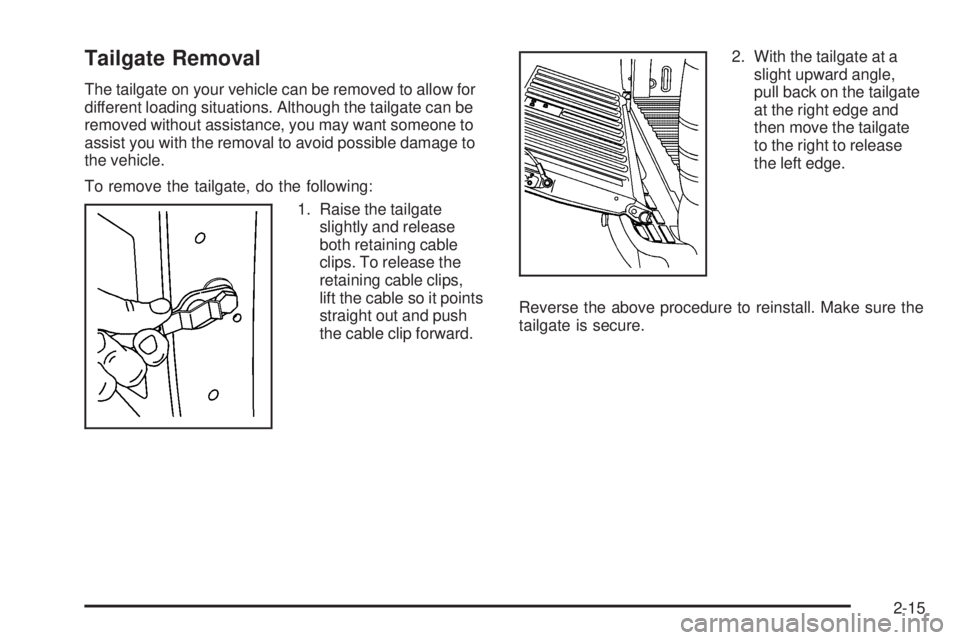
Tailgate Removal
The tailgate on your vehicle can be removed to allow for
different loading situations. Although the tailgate can be
removed without assistance, you may want someone to
assist you with the removal to avoid possible damage to
the vehicle.
To remove the tailgate, do the following:
1. Raise the tailgate
slightly and release
both retaining cable
clips. To release the
retaining cable clips,
lift the cable so it points
straight out and push
the cable clip forward.2. With the tailgate at a
slight upward angle,
pull back on the tailgate
at the right edge and
then move the tailgate
to the right to release
the left edge.
Reverse the above procedure to reinstall. Make sure the
tailgate is secure.
2-15
Page 111 of 600
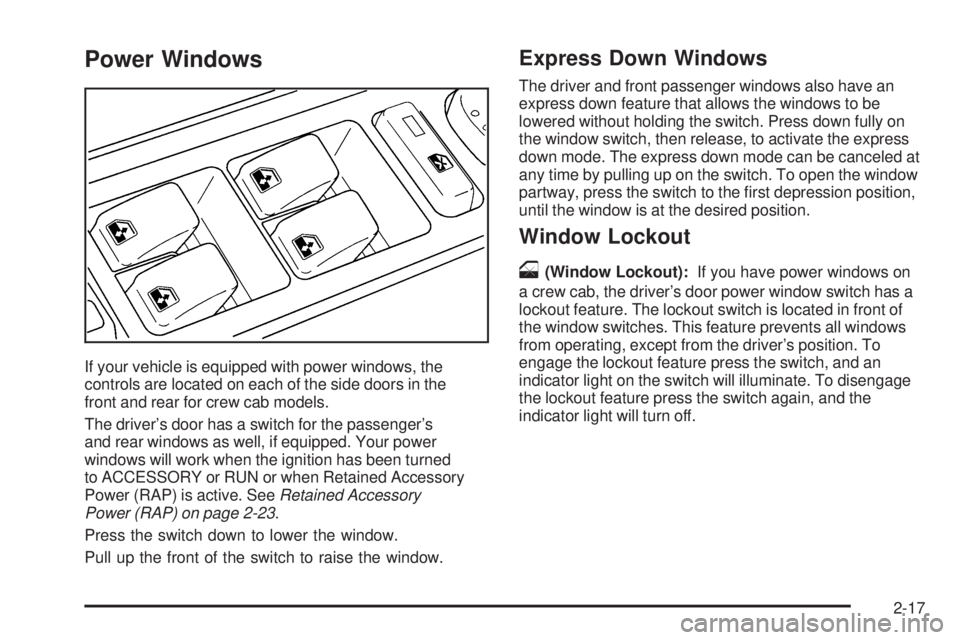
Power Windows
If your vehicle is equipped with power windows, the
controls are located on each of the side doors in the
front and rear for crew cab models.
The driver’s door has a switch for the passenger’s
and rear windows as well, if equipped. Your power
windows will work when the ignition has been turned
to ACCESSORY or RUN or when Retained Accessory
Power (RAP) is active. SeeRetained Accessory
Power (RAP) on page 2-23.
Press the switch down to lower the window.
Pull up the front of the switch to raise the window.
Express Down Windows
The driver and front passenger windows also have an
express down feature that allows the windows to be
lowered without holding the switch. Press down fully on
the window switch, then release, to activate the express
down mode. The express down mode can be canceled at
any time by pulling up on the switch. To open the window
partway, press the switch to the �rst depression position,
until the window is at the desired position.
Window Lockout
o
(Window Lockout):If you have power windows on
a crew cab, the driver’s door power window switch has a
lockout feature. The lockout switch is located in front of
the window switches. This feature prevents all windows
from operating, except from the driver’s position. To
engage the lockout feature press the switch, and an
indicator light on the switch will illuminate. To disengage
the lockout feature press the switch again, and the
indicator light will turn off.
2-17
Page 113 of 600
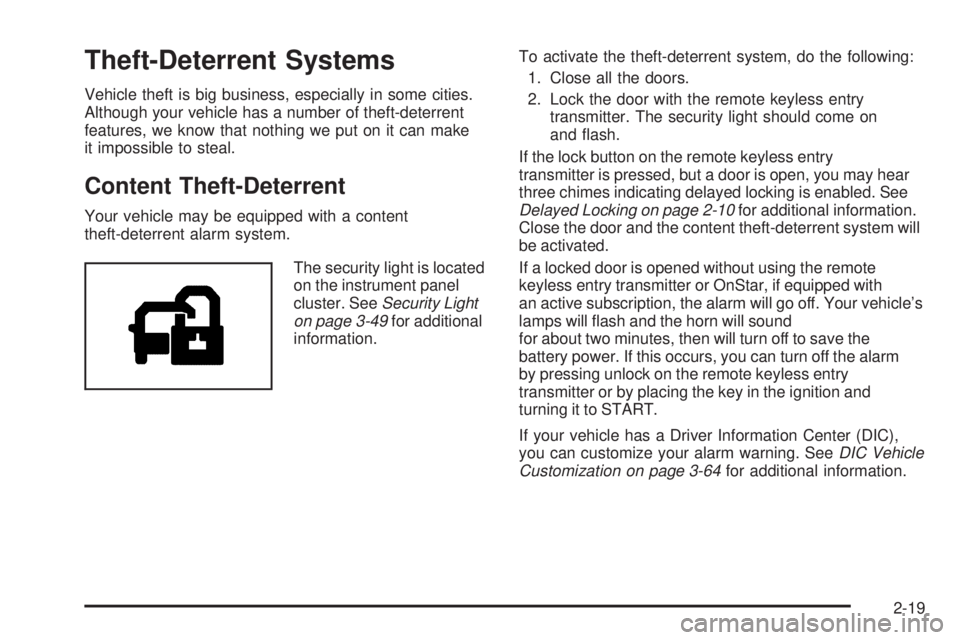
Theft-Deterrent Systems
Vehicle theft is big business, especially in some cities.
Although your vehicle has a number of theft-deterrent
features, we know that nothing we put on it can make
it impossible to steal.
Content Theft-Deterrent
Your vehicle may be equipped with a content
theft-deterrent alarm system.
The security light is located
on the instrument panel
cluster. SeeSecurity Light
on page 3-49for additional
information.To activate the theft-deterrent system, do the following:
1. Close all the doors.
2. Lock the door with the remote keyless entry
transmitter. The security light should come on
and �ash.
If the lock button on the remote keyless entry
transmitter is pressed, but a door is open, you may hear
three chimes indicating delayed locking is enabled. See
Delayed Locking on page 2-10for additional information.
Close the door and the content theft-deterrent system will
be activated.
If a locked door is opened without using the remote
keyless entry transmitter or OnStar, if equipped with
an active subscription, the alarm will go off. Your vehicle’s
lamps will �ash and the horn will sound
for about two minutes, then will turn off to save the
battery power. If this occurs, you can turn off the alarm
by pressing unlock on the remote keyless entry
transmitter or by placing the key in the ignition and
turning it to START.
If your vehicle has a Driver Information Center (DIC),
you can customize your alarm warning. SeeDIC Vehicle
Customization on page 3-64for additional information.
2-19
Page 114 of 600
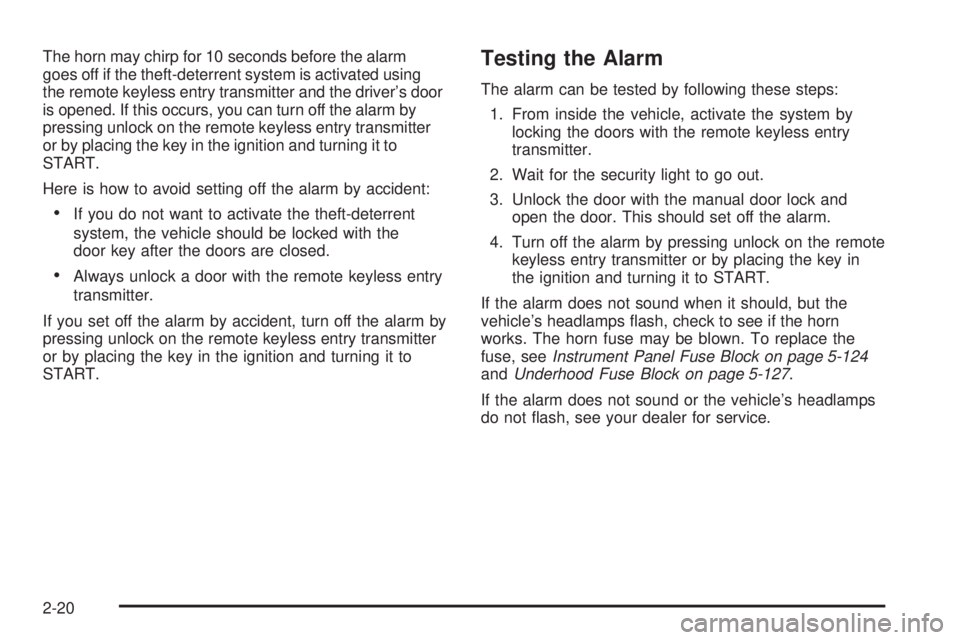
The horn may chirp for 10 seconds before the alarm
goes off if the theft-deterrent system is activated using
the remote keyless entry transmitter and the driver’s door
is opened. If this occurs, you can turn off the alarm by
pressing unlock on the remote keyless entry transmitter
or by placing the key in the ignition and turning it to
START.
Here is how to avoid setting off the alarm by accident:
If you do not want to activate the theft-deterrent
system, the vehicle should be locked with the
door key after the doors are closed.
Always unlock a door with the remote keyless entry
transmitter.
If you set off the alarm by accident, turn off the alarm by
pressing unlock on the remote keyless entry transmitter
or by placing the key in the ignition and turning it to
START.
Testing the Alarm
The alarm can be tested by following these steps:
1. From inside the vehicle, activate the system by
locking the doors with the remote keyless entry
transmitter.
2. Wait for the security light to go out.
3. Unlock the door with the manual door lock and
open the door. This should set off the alarm.
4. Turn off the alarm by pressing unlock on the remote
keyless entry transmitter or by placing the key in
the ignition and turning it to START.
If the alarm does not sound when it should, but the
vehicle’s headlamps �ash, check to see if the horn
works. The horn fuse may be blown. To replace the
fuse, seeInstrument Panel Fuse Block on page 5-124
andUnderhood Fuse Block on page 5-127.
If the alarm does not sound or the vehicle’s headlamps
do not �ash, see your dealer for service.
2-20
Page 115 of 600
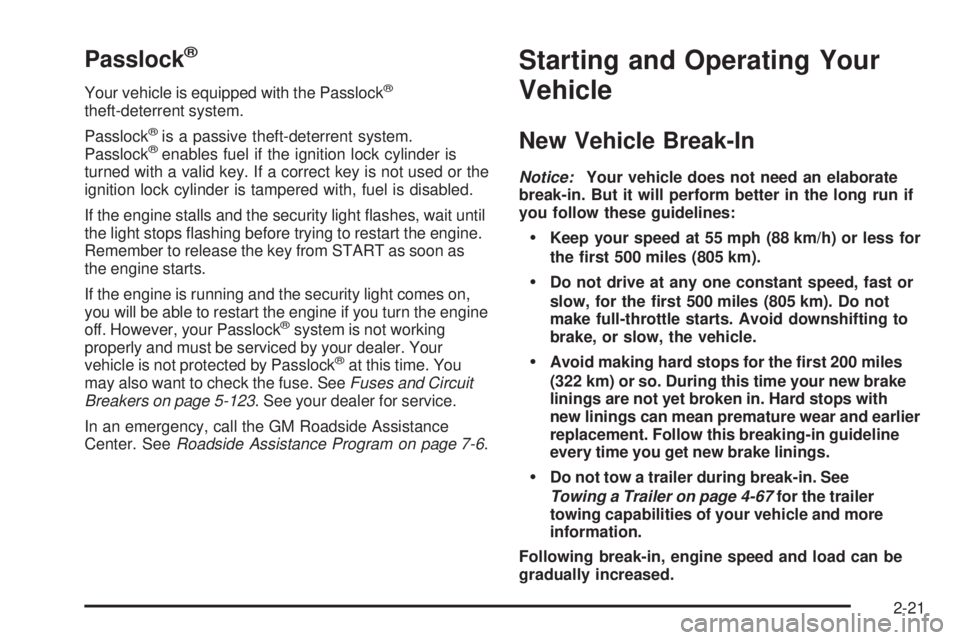
Passlock®
Your vehicle is equipped with the Passlock®
theft-deterrent system.
Passlock
®is a passive theft-deterrent system.
Passlock®enables fuel if the ignition lock cylinder is
turned with a valid key. If a correct key is not used or the
ignition lock cylinder is tampered with, fuel is disabled.
If the engine stalls and the security light �ashes, wait until
the light stops �ashing before trying to restart the engine.
Remember to release the key from START as soon as
the engine starts.
If the engine is running and the security light comes on,
you will be able to restart the engine if you turn the engine
off. However, your Passlock
®system is not working
properly and must be serviced by your dealer. Your
vehicle is not protected by Passlock
®at this time. You
may also want to check the fuse. SeeFuses and Circuit
Breakers on page 5-123. See your dealer for service.
In an emergency, call the GM Roadside Assistance
Center. SeeRoadside Assistance Program on page 7-6.
Starting and Operating Your
Vehicle
New Vehicle Break-In
Notice:Your vehicle does not need an elaborate
break-in. But it will perform better in the long run if
you follow these guidelines:
Keep your speed at 55 mph (88 km/h) or less for
the �rst 500 miles (805 km).
Do not drive at any one constant speed, fast or
slow, for the �rst 500 miles (805 km). Do not
make full-throttle starts. Avoid downshifting to
brake, or slow, the vehicle.
Avoid making hard stops for the �rst 200 miles
(322 km) or so. During this time your new brake
linings are not yet broken in. Hard stops with
new linings can mean premature wear and earlier
replacement. Follow this breaking-in guideline
every time you get new brake linings.
Do not tow a trailer during break-in. See
Towing a Trailer on page 4-67for the trailer
towing capabilities of your vehicle and more
information.
Following break-in, engine speed and load can be
gradually increased.
2-21
Page 125 of 600
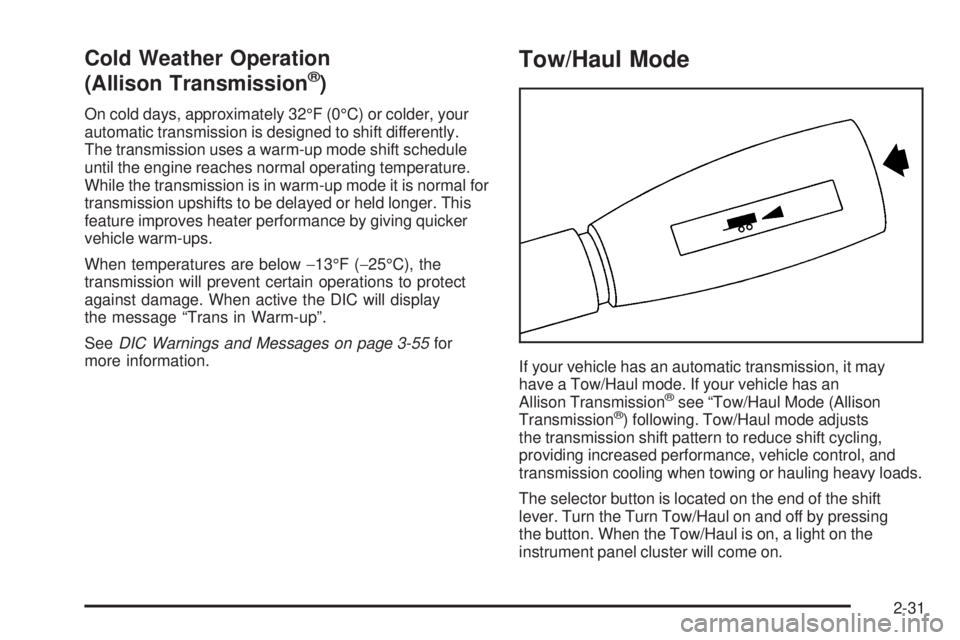
Cold Weather Operation
(Allison Transmission®)
On cold days, approximately 32°F (0°C) or colder, your
automatic transmission is designed to shift differently.
The transmission uses a warm-up mode shift schedule
until the engine reaches normal operating temperature.
While the transmission is in warm-up mode it is normal for
transmission upshifts to be delayed or held longer. This
feature improves heater performance by giving quicker
vehicle warm-ups.
When temperatures are below−13°F (−25°C), the
transmission will prevent certain operations to protect
against damage. When active the DIC will display
the message “Trans in Warm-up”.
SeeDIC Warnings and Messages on page 3-55for
more information.
Tow/Haul Mode
If your vehicle has an automatic transmission, it may
have a Tow/Haul mode. If your vehicle has an
Allison Transmission
®see “Tow/Haul Mode (Allison
Transmission®) following. Tow/Haul mode adjusts
the transmission shift pattern to reduce shift cycling,
providing increased performance, vehicle control, and
transmission cooling when towing or hauling heavy loads.
The selector button is located on the end of the shift
lever. Turn the Turn Tow/Haul on and off by pressing
the button. When the Tow/Haul is on, a light on the
instrument panel cluster will come on.
2-31
Page 126 of 600
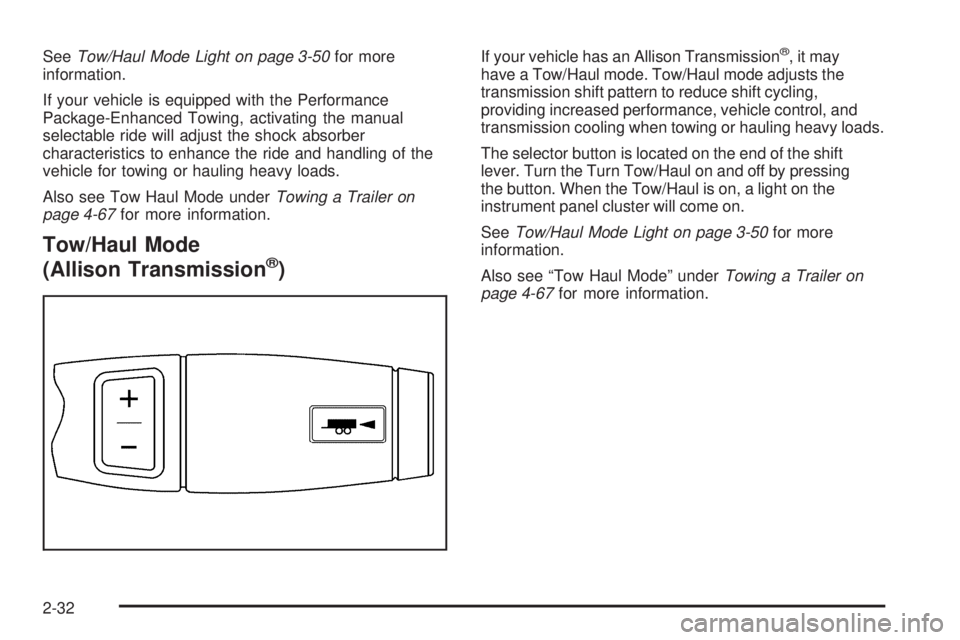
SeeTow/Haul Mode Light on page 3-50for more
information.
If your vehicle is equipped with the Performance
Package-Enhanced Towing, activating the manual
selectable ride will adjust the shock absorber
characteristics to enhance the ride and handling of the
vehicle for towing or hauling heavy loads.
Also see Tow Haul Mode underTowing a Trailer on
page 4-67for more information.
Tow/Haul Mode
(Allison Transmission®)
If your vehicle has an Allison Transmission®,itmay
have a Tow/Haul mode. Tow/Haul mode adjusts the
transmission shift pattern to reduce shift cycling,
providing increased performance, vehicle control, and
transmission cooling when towing or hauling heavy loads.
The selector button is located on the end of the shift
lever. Turn the Turn Tow/Haul on and off by pressing
the button. When the Tow/Haul is on, a light on the
instrument panel cluster will come on.
SeeTow/Haul Mode Light on page 3-50for more
information.
Also see “Tow Haul Mode” underTowing a Trailer on
page 4-67for more information.
2-32